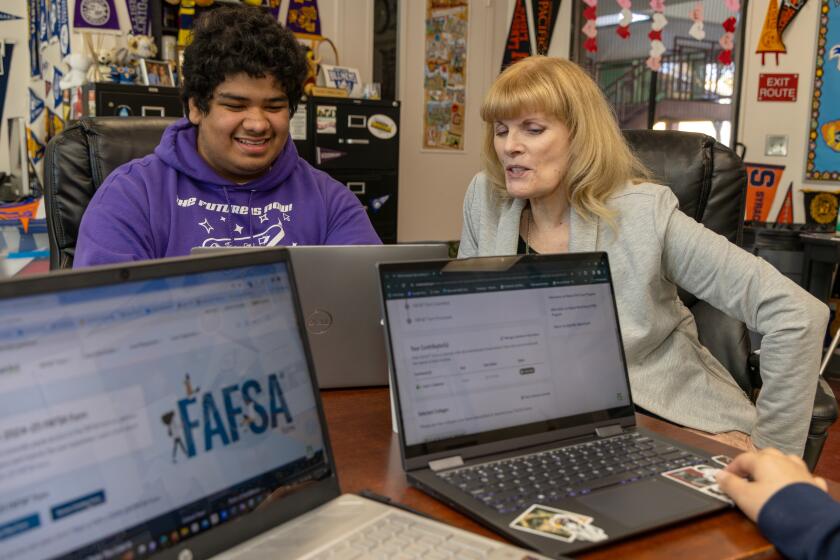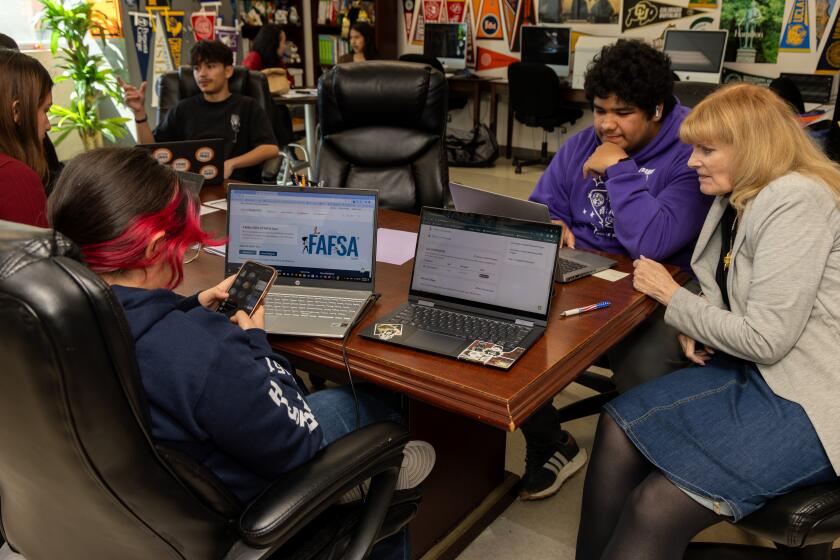California extends deadline for students seeking state financial aid amid FAFSA turmoil

California students will have an extra month to submit applications for state financial aid, a deadline extension to help with ongoing setbacks and delays that have plagued the roll out of new federal forms that colleges and states rely on to calculate a student’s scholarships and loans.
Federal officials alerted colleges of the latest mishap on Friday — errors in the processing of the Free Application for Federal Student Aid, or FAFSA, that have resulted in schools receiving inaccurate information about student eligibility for aid.
The deadline for Cal Grants and other state aid programs — that collectively dole out more than $2.3 billion — will be pushed back from April 2 to May 2 under legislation that took effect immediately Monday with Gov. Gavin Newsom’s signature.
The grants help students attending University of California, California State University or state community colleges. Students attending private California universities and some career colleges or technical schools can also be eligible.
Last week, the legislation had passed in both the state Assembly and state Senate, with not a single vote in opposition.
The extended deadline is one more attempt to ease what has become a long-running nightmare for students who depend on financial aid to attend college.
A chaotic rollout of a new federal financial aid form is roiling high schools and upending college admissions, impeding students from filling out the all-important FAFSA form.
The problems originated at the federal level, where the U.S. Department of Education was under orders from Congress to make the FAFSA simpler and more accessible.
But the new system was beset with delays, glitches and untested elements that needed to be modified.
Particularly hard-pressed were low-income families with complicated personal situations, including those in which a parent or student lacked a Social Security number.
The U.S. Department of Education this month announced that it had corrected the system to allow the online form to work for families lacking one or more Social Security numbers, although some information would still have to be submitted manually.
But some families still are having difficulties, and new problems seem to keep rolling out along with the fixes.
On Friday, the U.S. Department of Education announced that a miscalculation in the formula for the FAFSA processing resulted “in incorrect financial need information for several hundred thousand students being sent to colleges and universities,” according to the National Assn. of Student Financial Aid Administrators. “Those student records will eventually need to be reprocessed by the Department and resent to schools, leading to further delays in ... financial aid offers,” an association statement said.
“This is another unforced error that will likely cause more processing delays for students,” said association President Justin Draeger.
The group added in a statement: “At this stage in the game and after so many delays, every error adds up and will be felt acutely by every student who is counting on need-based financial aid to make their postsecondary dreams a reality.”
The federal description of the extent of the problem was more opaque. The main news site for the U.S. Department of Education contained no alert at all. Instead, an advisory was issued to “institutions and vendors,” noting that the problem “only” affects student information delivered to colleges prior to March 21.
In past years correct information would have been delivered months earlier.
The irony is that the new FAFSA is supposed to make things easier and faster but has resulted in the opposite. Federal education officials are scrambling to help.
The department stated that 1.3 million forms were not affected without saying how many student aid packages could be affected. This particular problem is a miscalculation that affects students who report having personal assets.
The FAFSA problems have proved rich political fodder for Republicans taking aim at the Biden administration — although Democrats also have been demanding explanations and fixes.
“These blunders are having real consequences for students. We need competency & accountability at the Department of Education,” Sen. Bill Cassidy, a Republican from Louisiana, posted on social media.
The latest issue follows the recent revelation that as of early March, a Department of Education inbox with 70,000 emails from applicants, containing essential information, had been untouched by department staffers.
The California deadline extension does not affect issues at the federal level. But it will give students more time to fill out applications without being hurt at the state level — where much of a student’s financial aid will come from.
A Cal Grant does not need to be paid back but applicants must apply using the FAFSA or California Dream Act Application by the deadline and meet all eligibility, financial and minimum grade-point-average requirements.
There are different kinds of Cal Grants, but students don’t have to figure that out. The application system does that for them. Grants range as high as $15,400 in a given year, with many factors determining the amount of aid available.
The proposed easing of the state deadline follows an earlier attempt to help at the state level.
In February, the University of California and California State University announced they would extend the May 1 deadline to May 15 for students to accept their admission offers for fall 2024.
The May 15 deadline applies to first-year students at all nine undergraduate UC campuses; CSU’s deadline is “no earlier” than May 15 for all 23 of its campuses.
Times staff writer Ashley Ahn contributed to this report.
More to Read
Sign up for Essential California
The most important California stories and recommendations in your inbox every morning.
You may occasionally receive promotional content from the Los Angeles Times.













